Introduction
My father served on HMS Wrangler when she was a training ship as a Stoker Mechanic in 1949 before being transferred to the cruiser HMS Gambia in 1950.
Then in April 2021, I received an email from Doreen Denny saying her brother, John Cornwall, served on her around 1953. John also served on HMSs Darling and Bermuda. John died in 1997. Because of Doreen's emails I decided to look for more information about HMS Wrangler and so this page was created.
Short History
HMS Wrangler was one of eight W-class destroyers built for the Royal Navy during World War II. Completed in 1944, the ship spent most of the war in the Far East and escorted British aircraft carriers as their aircraft attacked targets in the occupied Dutch East Indies and in Japan itself. Wrangler was present in Tokyo Bay when the Japanese formally surrendered on 2 September 1945.
She served as a training ship after the war until she was converted into a Type 15 frigate in the early 1950s and subsequently sold to the South African Navy later that decade. The ship was renamed Vrystaat in South African service and made many overseas port visits before corrosion problems caused her to be reduced to reserve in 1963. Vrystaat was sunk as a target by a South African submarine in 1976.
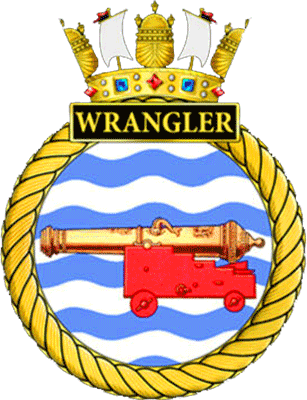
HMS Wrangler's crest
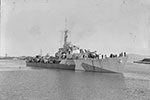

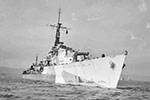
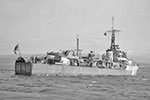
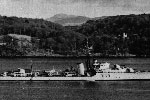

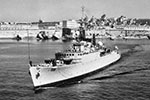
Pennant Numbers
HMS Wrangler had at least 4 pennant numbers that I know of, R48, D36, D158, and F157
She originally had the number R48 but when she joined SW Pacific Flotilla under US Navy overall command in May 1945, she was given the pennant number D36 to conform to the US system. After the war she reverted back to R48. From September 1946 until 1950 the ship was with the Rosyth Local Flotilla as a boys' training ship, and during this time had the pennant number D158. In 1951, she underwent a 2-year reconstruction to convert her into a Type 15 anti-submarine frigate and in 1953, she received the pennant number F157.
During this reconstruction large parts of her superstructure were rebuilt using aluminium and it was the galvanic or bimetallic corrosion between that and her original steel that was too expensive to repair and eventually caused her to be taken out of service.
Peter Murdoch did his training on HMS Wrangler in 1946. He says that,
in January 1946, when I joined [the shore-based training establishment] HMS Ganges at Shotley as a boy seaman. The war had just ended and I was working in an aircraft factory – Cunliffe-Owen – which was based at Eastleigh, Southampton. When they closed down [in 1947] I didn’t know what to do, so I joined the Navy on my sixteenth birthday.
I did my year’s basic training there, and when we finished, there was a group of 15 of us who were selected to go on [the training destroyer] HMS Wrangler at Rosyth, Scotland. We went up to the North Cape looking for mines. This was all part of my training and I was there for about three months.
More Crew
It is now difficult to identify the crew of HMS Wrangler, but every now and then an article turns up about one of them.
John Hughes and Richard "Gordon" Robinson who both served during WWII.
Mike Andrews served in the RN from 1947 to 1974. He trained a ST. Vincents and served on Wrangler, Mounts Bay, Berry Head, Alert, Cumberland and Exmouth. Mike died on August 18, 2018 aged 86.
World War II Service
The ship was launched on December 30, 1943 and completed on July 14, 1944, and so only joined service late in WWII. She was assigned to the 27th Destroyer Flotilla, together with all of her sister ships, upon completion and Wrangler was working up at Scapa Flow with the Home Fleet from July 21 to August 16. She then proceeded to the Mediterranean for several months before she was assigned to the Eastern Fleet by late 1944. During Operation Robson, an aerial attack on the oil refinery complex at Pangkalan Brandan, Sumatra, in mid-December, Wrangler escorted the main body of the fleet. Afterwards, the ship sailed to Bombay, India, to have her boiler tubes replaced, a lengthy job that took from January 14 to May 19, 1945. By July 17, the ship was en route, together with her sister Wakeful to reinforce the British Pacific Fleet operating off the coast of Japan. HMS Wrangler was present in Tokyo Bay for the official surrender on September 2, 1945.
Operation Robson: On December 17, 1944, Wrangler joned Rear Admiral (later Admiral of the Fleet) Sir Philip Vian’s British Task Force 67 whch consisted of carriers HMS Indomitable and Illustrious escorted by light cruisers HMS Argonaut, Black Prince, and Newcastle, screened by destroyers HMS Kempenfelt, Wakeful, Wessex, Whirlwind and Wrangler. On December 20, the force launched a relatively unsuccessful air strike on the Pangkalan Brandan refinery by twenty-eight Grumman Avengers, 16 Grumman Hellcats and 16 Chance-Vought Corsairs attempted to attack the refinery, but because of bad weather over Pangkalan Brandan the planes have to divert to refineries, railway and harbor installations at Belewan Deli.
HMS Wrangler took part in the rescue operation after the earthquake of August 1953 that struck Greece. During August 1953, there were 113 earthquakes recorded around the southern Greek Ionian islands between Kefalonia and Zakynthos, the latter being known to the British as Zante. Four of the earthquakes were major and the one on August 12 was massive, recorded as 7.2 on the Richter scale. This earthquake very caused severe damage to the islands of Kefalonia and Zakynthos and raised the whole island of Kefalonia by 2 feet. In Zakynthos, the capital of Zakynthos the island, only two buildings survived. All the buildings in the south of Kefalonia were destroyed.


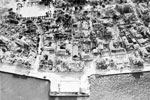
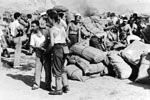

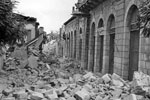
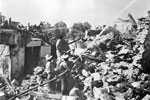
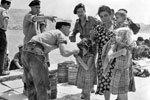
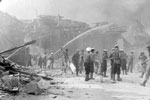
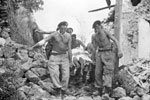
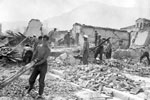
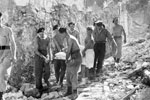
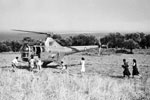
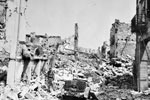
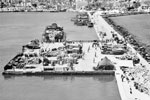
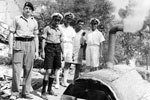



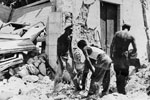
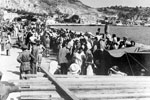
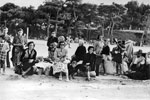
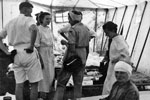
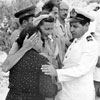
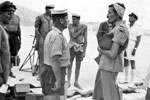
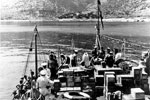
William Abel, P/MX.59284, was serving as Chief Engine Room Artificer on HMS Wrangler during these operations. The London Gazette: 16 August, 1954 reported that "The Queen has been graciously pleased to approve the award of the British Empire Medal (Military Division) for distinguished service in the Greek earthquake relief operations in August, 1953" to him.
In 1954, HMS Wrangler was involved in the search for wreckage of the BOAC de Havilland Comet airliner G-ALYP, known as "Yoke Peter", that crashed in the Mediterranean Sea near the island of Elba.
On January 10, 1954 a little after 9.30am BOAC Comet ‘Yoke Peter’, Flight 781, took off after a refuelling stop from Ciampino Airport, Rome while en-route from Singapore to London. It reached 25,000 feet at about 09.51am when it disintegrated and fell into the Tyrrhenian Sea off the Island of Elba. Six crew and twenty nine passengers were killed. The remains of the aircraft fell into 150 metres of water.
By January 23, 1954, HMS Wrangler was on scene as Headquarters Ship and RFA Sea Salvor, the Mediterranean Fleet’s salvage vessel which had been en-route from Gibraltar to Malta; plus HMS Barhill, HMS Brigand and HMS Sursay, had joined forces at the scene. HMS Striker, HMS Wakeful and HMS Whirlwind arrived later.
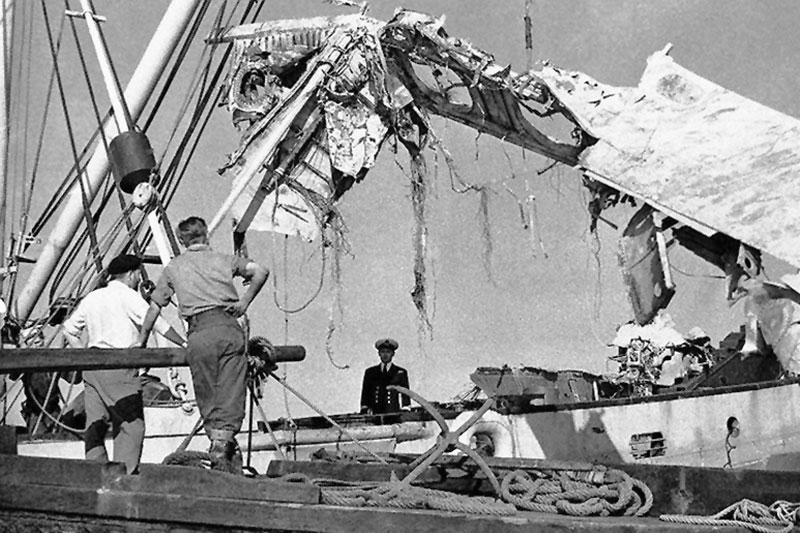
The recovery operation of Comet G-ALYP
This is the main spar centre section of the plane
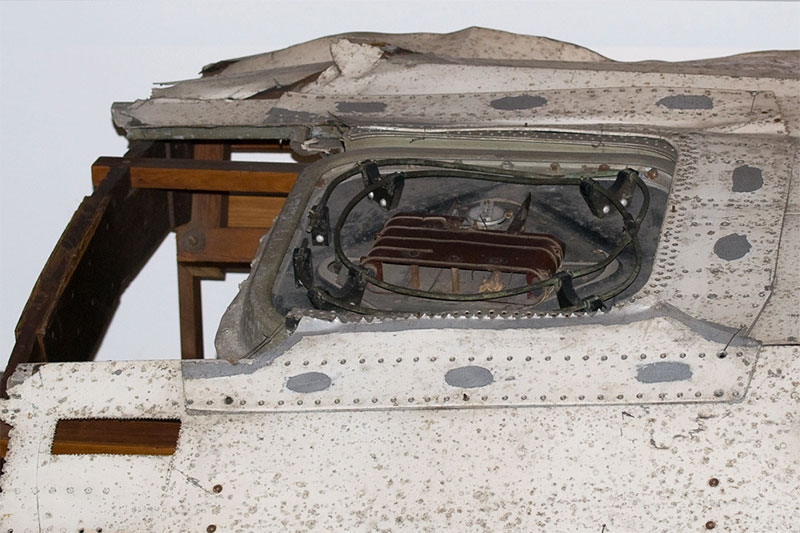
Part of the recovered Comet G-ALYP
It was determined it was stress cracks around this window that caused the catastrophic decompression
There is a memorial in the cemetery of Porto Azzurro, where some of the victims are buried and a list of the twenty whose remains were never found.
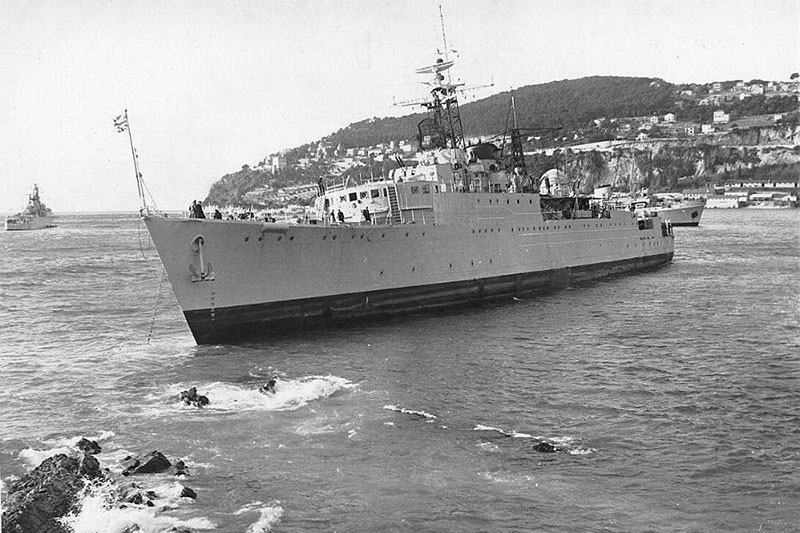
HMS Wrangler aground
On February 4, 1955, she ran aground at Villefranche sur Mer, France, but was refloated on February 6, 1955 by French Navy and Italian Navy tugs.
Sources
Blind Veterans UK: One of the Lucky Ones
Bureau of Aircraft Accidents Archives: Crash of a De Havilland DH.106 Comet 1 off Elbe Island
Flickr: Frigate RN
Historical RFA: The Crash of BOAC Comet Yoke Peter and RFA Sea Salvor
Imperial Japanese Navy: Shosei Maru
Imperial War Museums: HMS Wrangler
Naval History: HMS Wrangler
Navy News, October 2018
RN Communications Branch Museum: The Royal Navy Pennant Numbering System
Ships Nostalgia: HMS Wrangler
Tales from the Supply Depot: HMS Wrangler Photograph
The London Gazette: 16 August, 1954
The Public "I": Spirits of the Dead
Wikipedia: BOAC Flight 781
Wikipedia: HMS Wrangler
This page created August 14, 2021; last modified August 15, 2021




































